According to the Koran, on the night of July 27 in the year 621, the Prophet Mohammed (c. 570-632), responding to a call from Allah, rode on a steed called Buraq from Mecca to the “Farthest Mosque” where Mohammed is said to have been granted an audience with Allah. The famous trip is known as the Night Journey and Ascension to Heaven and is the origin of the Muslim holiday celebrating the Isra and Miraj.
The Dome of the Rock located on the Temple Mount in the Old City of Jerusalem was built between 688 and 692 and is constructed around a large foundation stone which, according to legend, is where Mohammed ascended to heaven.
The Dome of the Rock is the oldest extant work of Islamic architecture and has undergone a number of restorations throughout its more than 1000-year history. During the early days of Islam, the Dome of the Rock’s exterior was not a uniform shape. In fact, its later octagonal construction is thought to have been inspired by a nearby Christian church, so that the Dome of the Rock’s archetypal dome, familiar today, in fact borrows its origins from Byzantine architecture. Furthermore, the minaret which now dominates the skyline next to the Dome of the Rock was not an original feature of the temple.
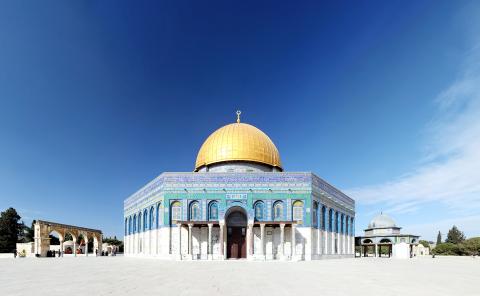
Photo: Wikimedia Commons
照片:維基共享資源
A unique aspect of the Dome of the Rock’s architecture is that inside the temple there are no statues, portraits or offerings since Islam emphasizes the exclusive worship of Allah and forbids any worship of other idols. For this reason, the interior of the temple is made up only of columns and decoration on the walls and dome, which feature scriptures written in a variety of Arabic calligraphy styles and abstract decorative designs.
The Dome of the Rock’s interior makes use of a large amount of geometric imagery and complex ceremonial floral designs, while repeating, rhythmical visuals abound which give worshippers a feeling of the order and never-ending magnitude of the universe.
(Translated by Edward Jones)
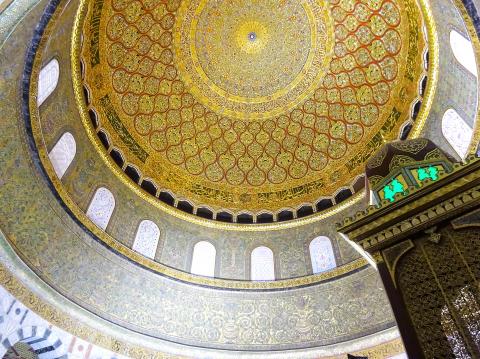
Photo: Wikimedia Commons
照片:維基共享資源
據《古蘭經》記載,先知穆罕默德(生卒年約為西元五七○~六三二年)在西元六二一年七月二十七日(伊斯蘭曆前一年七月十七日)夜晚,應真主之召乘著馬形神獸布拉克由麥加來到遠方一座寺院,直昇天庭晉見真主。這段旅程便是著名的「夜行登霄」,也是伊斯蘭教「登霄節」的由來。
耶路撒冷舊城聖殿山上的「圓頂清真寺」(建成年代為西元六八八~六九二年),圍繞一塊巨岩而築,相傳這塊岩石便是穆罕默德登天之處。
圓頂清真寺是現存最早的伊斯蘭建築之一,一千多年來幾經整建。在伊斯蘭教初始,清真寺的外觀並無既定形式規範。事實上,圓頂清真寺後來的八邊形結構,咸認是參考附近的一間基督教教堂;現今視為清真寺標準元素的穹頂,則是借自於拜占庭建築風格。聳立於清真寺旁天際線的高聳宣禮塔,當時仍尚未出現。
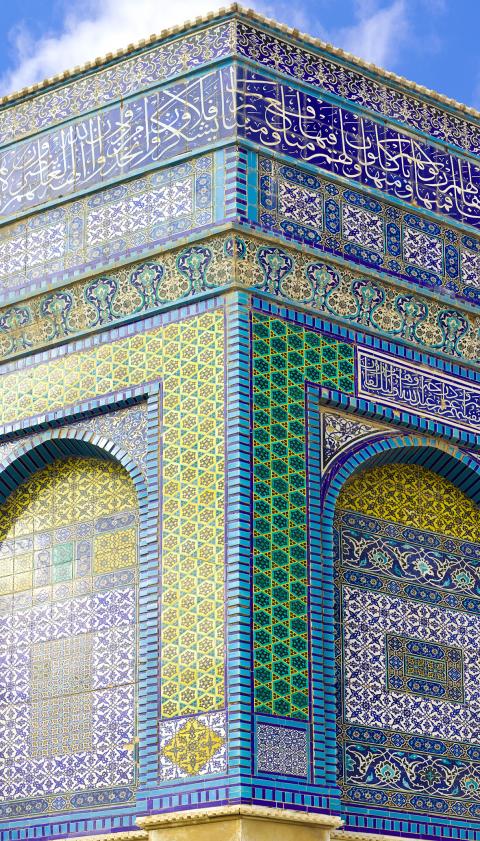
Photo: Wikimedia Commons
照片:維基共享資源
然而,清真寺建築自始即確定的特色是,寺內沒有任何雕像、畫像或供品,因為伊斯蘭教強調應專注禮拜真主,禁止祭拜偶像。因此圓頂清真寺室內只有圍繞的柱廊,牆面及穹頂之裝飾則是用各種阿拉伯書法字體的經文,以及抽象花紋構成。
圓頂清真寺內外牆都運用了大量的幾何圖形及繁複的花草花紋樣式,呈現出重複而有節奏的鋪天蓋地視覺效果,令朝拜者感到宇宙的秩序及無窮盡之感。
(台北時報林俐凱)
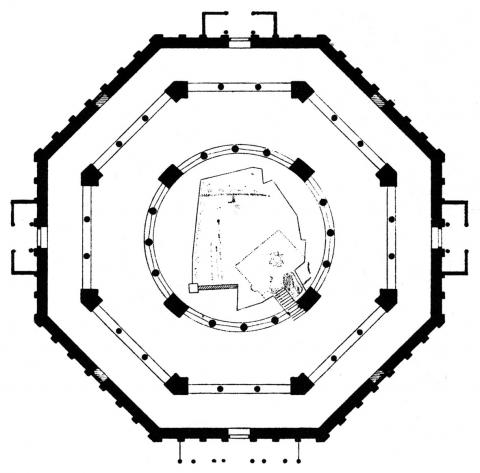
Photo: Wikimedia Commons
照片:維基共享資源
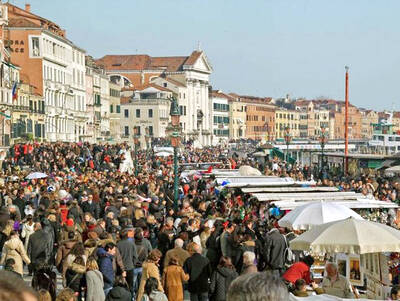
As global travel rebounds following the COVID-19 pa ndemic, the longstanding issue of overtourism has returned stronger than ever. Throughout 2024, numerous popular destinations worldwide struggled with tourist numbers that far exceeded their infrastructural and environmental capacities. Not only does this surge congest streets and pollute landscapes, but it also endangers cultural sites and disrupts the daily lives of residents. In response to the growing problem of “overtourism,” various nations have adopted diverse strategies, some of which have sparked controversy. Venice, Italy, has not hesitated to take bold action; since 2024, the city has implemented one of the

In an effort to fight phone scams, British mobile phone company O2 has introduced Daisy, an AI designed to engage phone con artists in time-wasting conversations. Daisy is portrayed as a kindly British granny, exploiting scammers’ tendency to target the elderly. Her voice, based on a real grandmother’s for authenticity, adds to her credibility in the role. “O2” has distributed several dedicated phone numbers online to direct scammers to Daisy instead of actual customers. When Daisy receives a call, she translates the scammers’ spoken words into text and then responds to them accordingly through a text-to-speech system. Remarkably, Daisy

A: This year’s Met Gala, the Metropolitan Museum of Art’s fundraiser, is coming on the first Monday of May. B: The event, featuring a lineup of stars, is often praised as fashion’s Oscars. A: Some Asian stars, like Taiwanese pop diva Jolin Tsai, have also attended in the past. B: What are the theme and dress code this time? A: This year’s theme is “Superfine: Tailoring Black Style.” It’s the first time since 2003 that the theme is focusing on menswear. The dress code is “Tailored for You.” A: 哇今年的大都會博物館慈善晚宴「Met Gala」,即將在5月第一個星期一登場。 B: 這可是被譽為「時尚奧斯卡」的年度盛事,許多巨星都會參加耶。 A:

A: Isn’t the Met Gala, the Metropolitan Museum of Art’s fundraiser, chaired by Vogue editor-in-chief Anna Wintour? B: Yeah, the blockbuster “The Devil Wears Prada” is allegedly based on her story. A: This year’s four co-chairs are actor Colman Domingo, F1 driver Lewis Hamilton, rapper A$AP Rocky and Louis Vuitton men’s creative director Pharrell Williams. B: And basketball superstar LeBron James is the honorary chair. A: I can’t wait to see the lineup of stars on the red carpet. A: 大都會博物館慈善晚宴「Met Gala」,是《時尚》雜誌全球總監安娜溫圖為該館服裝學院主辦的募款活動吧? B: 對啊,電影《穿著普拉達的惡魔》據說是以她為範本。 A: 今年晚宴共同主席還有:演員柯爾曼多明哥、F1賽車手路易斯漢米頓、饒舌歌手A$AP洛基、LV男裝創意總監菲董。 B: 籃球巨星勒布朗詹姆斯則是榮譽主席。 A: 紅毯上的全球星光真令人期待! (By Eddy Chang, Taipei Times/台北時報張迪)